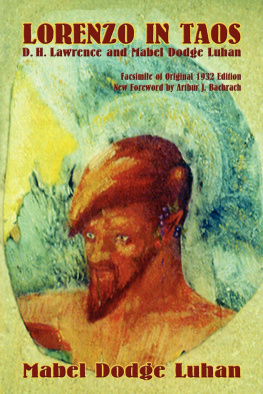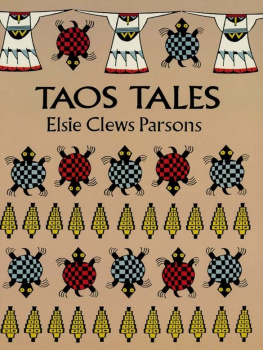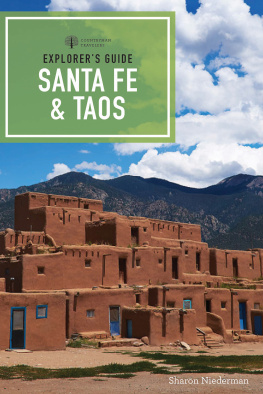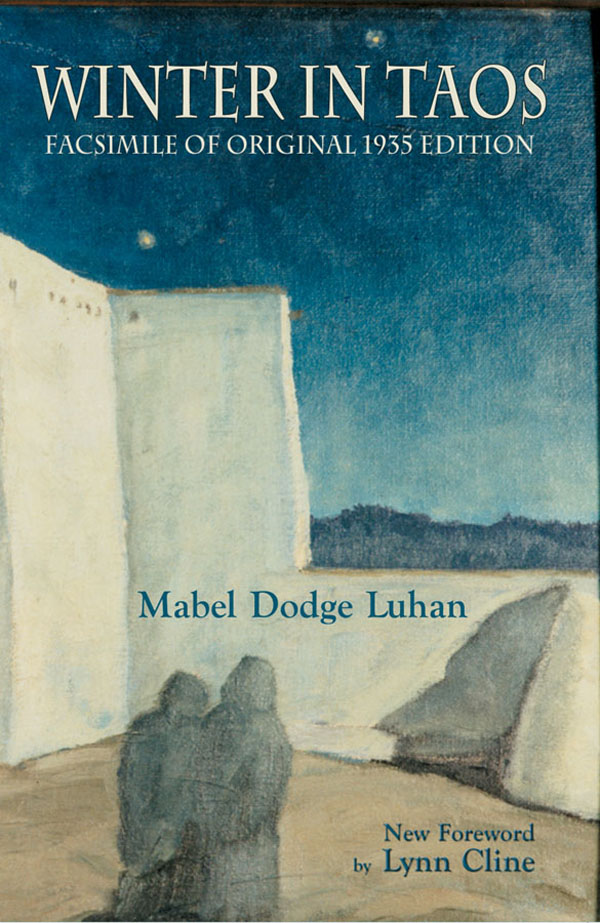WINTER IN TAOS
WINTER IN TAOS
FACSIMILE OF ORIGINAL 1935 EDITION
by
Mabel Dodge Luhan
New Foreword
by
Lynn Cline


New Material 2007 by Sunstone Press. All Rights Reserved.
No part of this book may be reproduced in any form or by any electronic or mechanical means including information storage and retrieval systems without permission in writing from the publisher, except by a reviewer who may quote brief passages in a review.
Sunstone books may be purchased for educational, business, or sales promotional use.
For information please write: Special Markets Department, Sunstone Press,
P.O. Box 2321, Santa Fe, New Mexico 87504-2321.

Library of Congress Cataloging-in-Publication Data
Luhan, Mabel Dodge, 1879-1962.
Winter in Taos : facsimile of original 1935 edition / by Mabel Dodge Luhan ; new foreword by Lynn Cline.
p. cm. -- (Southwest heritage series)
Originally published: New York : Harcourt, Brace, and Co., c1935.
ISBN 978-0-86534-593-5 (softcover : alk. paper)
1. Taos (N.M.)--Social life and customs--20th century. 2. Winter--New Mexico--Taos--History--20th century. 3. Luhan, Mabel Dodge, 1879-1962. 4. Luhan, Mabel Dodge, 1879-1962Homes and hauntsNew MexicoTaos. 5. Taos (N.M.)Biography. 6. Women intellectualsNew MexicoTaos Biography. 7. Women intellectualsUnited StatesBiography. I. Title.
F804.T2L8 2007
978.953--dc22
2007023142


WWW.SUNSTONEPRESS.COM
SUNSTONE PRESS / POST OFFICE BOX 2321 / SANTA FE, NM 87504-2321 /USA
(505) 988-4418 / ORDERS ONLY (800) 243-5644 / FAX (505) 988-1025
The Southwest Heritage Series is dedicated to Jody Ellis and Marcia Muth Miller, the founders of Sunstone Press, whose original purpose and vision continues to inspire and motivate our publications.
CONTENTS
I
THE SOUTHWEST HERITAGE SERIES
The history of the United States is written in hundreds of regional histories and literary works. Those letters, essays, memoirs, biographies and even collections of fiction are often first-hand accounts by people who wanted to memorialize an event, a person or simply record for posterity the concerns and issues of the times. Many of these accounts have been lost, destroyed or overlooked. Some are in private or public collections but deemed to be in too fragile condition to permit handling by contemporary readers and researchers.
However, now with the application of twenty-first century technology, nineteenth and twentieth century material can be reprinted and made accessible to the general public. These early writings are the DNA of our history and culture and are essential to understanding the present in terms of the past.
The Southwest Heritage Series is a form of literary preservation. Heritage by definition implies legacy and these early works are our legacy from those who have gone before us. To properly present and preserve that legacy, no changes in style or contents have been made. The material reprinted stands on its own as it first appeared. The point of view is that of the author and the era in which he or she lived. We would not expect photographs of people from the past to be re-imaged with modern clothes, hair styles and backgrounds. We should not, therefore, expect their ideas and personal philosophies to reflect our modern concepts.
Remember, reading their words and sharing their thoughts is a passport back into understanding how the past was shaped and how it influenced todays world.
Our hope is that new access to these older books will provide readers with a challenging and exciting experience.
II
FOREWORD TO THIS EDITION
by Lynn Cline
M abel Dodge Luhan has yet to achieve the kind of iconic status bestowed on Georgia OKeeffe and Willa Cather, despite her nearly legendary presence in Taos, New Mexico from late 1917 until her death there in 1962. Instead, her lesser-known legacy includes a rambling adobe that has been turned into a historic inn; an extensive collection of papers archived at Yales Beinecke Library; a four-volume autobiography, Intimate Memoirs; and this lyrical book, Winter in Taos, which offers a simple description of life in 1930s northern New Mexico patterned on the cycles of the seasons.
Luhans success as a writer pales in comparison to the stature of the literary guests she invited to Taos, including author D.H. Lawrence, poet Robinson Jeffers, and playwright and novelist Thornton Wilder. She never intended, however, to become a famous scribe. Having settled in Taos after living in Florence, Italy and Greenwich Village, New York, where her influential salons earned her an international reputation, she sought to put Taos, and herself as an arbiter of culture, on the world map.
Entranced by northern New Mexicos rugged landscape and ancient cultures, Luhan hoped to reveal Pueblo cultural traditions to the Western world, believing that the Pueblo peoples life rhythms, bound tightly to the natural world, could restore a modern civilization beleaguered by war and bereft of faith. She worked hard to ensure that Cather, OKeeffe, Lawrence, Jeffers and dozens of other significant creative guests who trekked to her adobe compound experienced the power of Taos first-hand.
Luhan fervently hoped that Lawrence would write a book about Taos Pueblo that would convince Americans to see Taos the way she did. Lawrence, who didnt share her enthusiasm for Pueblo culture, never produced such a book, though he did fall in love with the regions beauty. Other guests found life in Taos fascinating, but too remote and isolated for their tastes. Luhan, however, remained determined to live out her dream. She married Tony Luhan, a Taos Pueblo man, and immersed herself as much as possible in a new world that replaced all the ways I had known with others, more strange and terrible and sweet than any I had ever been able to imagine, she wrote in Edge of Taos Desert.
Published in 1935, Winter in Taos starkly contrasts Luhans memoirs, Background(1933), European Experiences(1935), Movers and Shakers(1936) and Edge of Taos Desert(1937). The four volumes, inspired by Marcel Prousts Remembrances of Things Past, begin with her birth in 1879 in Buffalo, N.Y. to a wealthy Victorian family and follow her life through three failed marriages, numerous affairs, and ultimately a feeling of being nobody in myself, despite years of psychoanalysis and a luxurious lifestyle on two continents among the leading literary, art and intellectual personalities of the day.
Winter in Taos unfolds in an entirely different pattern, uncluttered with noteworthy names and ornate details. With no chapters dividing the narrative, it takes place on a single wintry day, yet moves well beyond the moment as Luhan describes her simple life in this new world from season to season, following a thread that spools out from her consciousness as if shes recording her thoughts in a journal. My pleasure is in being very still and sensing things, she writes, sharing that pleasure with the reader by describing the joys of adobe rooms warmed in winter by aromatic cedar fires; fragrant in spring with flowers, and scented with homegrown fruits and vegetables being preserved and pickled in summer. She also delights in describing the traits of her cat, dogs, horses and the flock of pigeons residing at the 17-room adobe she and Tony designed that holds me, works me to death, bores me and will not let me go!









